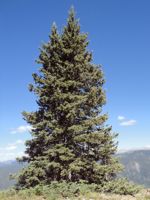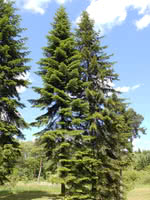Mon-Fri 9am - 5pm Mountain time
Douglas Fir vs Siberian Fir
Pseudotsuga menziesii var. glauca
Abies sibirica
NOT AVAILABLE THIS SEASON - MIGHT RETURN
(new stock expected: fall of 2027)
Douglas Fir is a large coniferous tree with a pyramidal shaped crown.
This attractive feature tree, with its distinctive drooping cones, is perfect for any grower who has lots of space and lives in a warm enough region. Douglas Firs make exceptional Christmas trees.
It is not suitable to all growing environments. Do some research and make sure this tree is right for you.
Our seed source is typically from the interior of BC and rocky mountain areas. We do not produce coastal seed source Douglas Fir as it is better suited to its native range and some taxonomists believe the two seed sources might be distinct.
Siberian Fir is an evergreen tree best known for its strong aroma. This tree's needles are popular for essential oils and aromatherapy. It also grows softwood that is used for furniture and wood pulp. This species is very cold hardy and shade tolerant.
This species is bright green and conical shaped. Most interesting is its upright blue cones that fade into brown as they mature.

